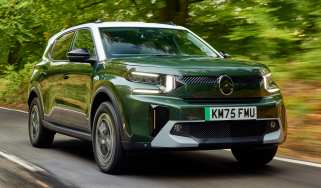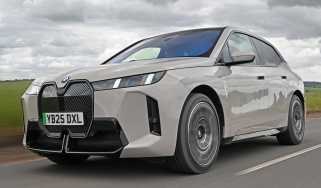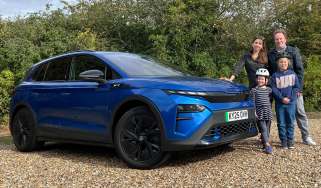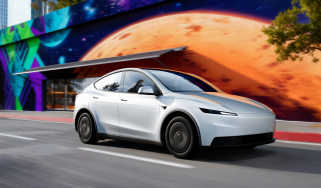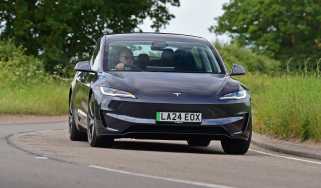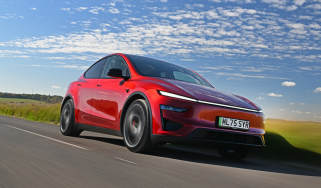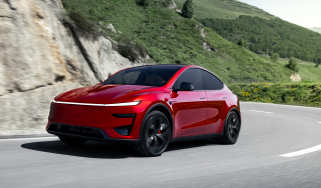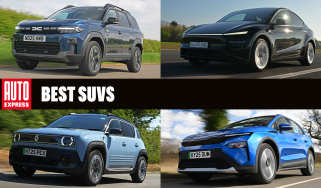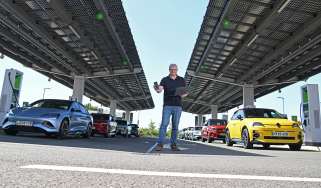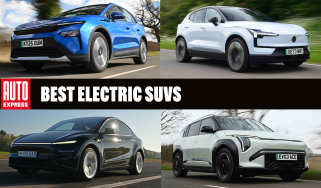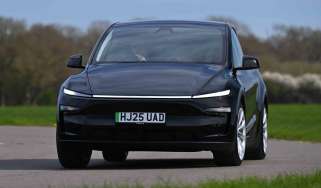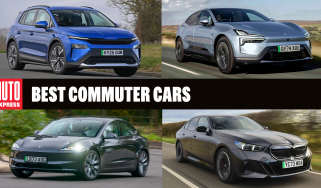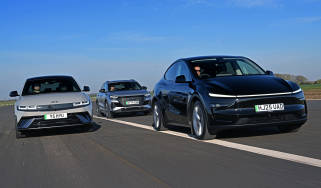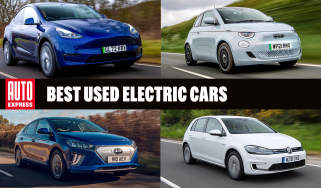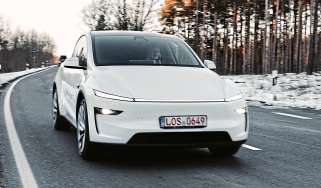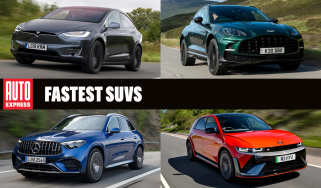Tesla Model Y review
The Model Y remains hugely popular and our tests have consistently shown it’s one of the easiest EVs to live with

Our opinion on the Tesla Model Y
While CEO Elon Musk divides opinion, there’s no doubt that the Tesla Model Y is one of the most popular and best EVs that’s currently available to buy. It was good before, but Tesla’s engineers made a series of notable improvements to the car in 2025, improving matters further.
The new touchscreen-only controls won’t be for everyone, and we’d like a few more physical buttons for key features to help with day-to-day driving. Both the ride and handling have been improved, however, while battery efficiency remains a big strong point. Combine all this with Tesla’s market-leading Supercharger network, and the Model Y will continue to make a lot of sense for a lot of buyers. It’s simply one of the most rounded electric SUVs available on today’s market.
About the Tesla Model Y
With the Tesla Model Y, the US company introduced a car that was just right for so many UK buyers’ demands. Sure enough, Tesla’s creation was the fifth best selling car in the UK in 2024 and the best selling electric car overall.
The mid-size SUV is based on the same running gear as the Tesla Model 3 saloon, but the extra height of the body offers more space for families, while the slippery shape means there isn’t much compromise in terms of efficiency.
Used - available now

2023 Tesla
Model Y
54,183 milesAutomaticElectric
Cash £22,600
2023 Tesla
Model Y
27,584 milesAutomaticElectric
Cash £25,600
2023 Tesla
Model Y
37,804 milesAutomaticElectric
Cash £24,300
2023 Tesla
Model Y
64,204 milesAutomaticElectric
Cash £20,300Tesla offers two battery sizes in the Model Y: 63kWh for the Standard Range car and 83kWh for the Long Range. As a result, the base model can travel up to 311 miles on a full charge, while the rear-wheel drive Long Range model has the best range at 387 miles. Adding a second motor for four-wheel drive reduces the range slightly, but it’s still pretty good, at 364 miles. A Model Y Performance model has returned to the line-up with a 460bhp power output and a 360-mile range.
We’ve tested various Model Ys in the UK, the US and Europe as well as carrying out detailed head-to-head tests on UK roads against the Audi Q4 e-tron, VW ID. Buzz, Hyundai Ioniq 5, Lexus RZ and BMW iX1. It performed very well, winning the test on all bar one of those occasions, and we built up a detailed understanding of its strengths and weaknesses.
Tesla Model Y prices and latest deals
The cheapest Model Y is the Standard Range Rear-Wheel Drive from £45,000. The Long Range Rear-Wheel Drive is around £49,000, then you have the Long Range All-Wheel Drive at £52,000 and the Performance taking the flagship role at £61,990.
There are leasing options on all Tesla Model Y variants available on the Auto Express Buy A Car service. If you want to save some cash there are also loads of older used Tesla Model Ys starting from around £20,000.
Performance & driving experience

| Pros |
|
| Cons |
|
The stand-out thing about the Tesla Model‘s driving experience is its straight-line pace. Even in base form and by the standards of other mid-size electric SUVs, acceleration is very lively. It’s not the most engaging car of its type to drive around corners but the latest models have improved on this score as well as in terms of comfort and refinement.
The Standard Range model comes with a 63kWh battery and a single rear-mounted electric motor that produces 279bhp. The more expensive Long Range version still has rear-wheel drive, but features an 83kWh battery and an electric motor tuned to make 308bhp. The Long Range AWD uses the same 83kWh battery as the rear-drive model, but it features two electric motors – one for each axle - that make a combined 375bhp. Above this is the Performance with its dual-motor system putting out 460bhp.
Performance, 0-60mph acceleration and top speed
No two ways about it, Tesla Model Y is quick. For the Standard Range model, the 0-60mph time is quoted at 5.6 seconds, while the heavier but more powerful Long Range car manages it in 5.4 seconds. The AWD version reduces this sprint to 4.6 seconds, although there’s an optional acceleration-boost package that lowers the time to 4.1 seconds if you add it.
The Tesla Model Y Performance, as the name suggests, is the quickest to 60mph - taking just 3.3 seconds, which is 0.2 seconds quicker than the original pre-facelift Model Y Performance and quicker than many top high-performance petrol cars. All versions of the Tesla Model Y have a top speed limited to 125mph.
From our experience, the Standard Range car’s straight-line punch will be more than enough for most drivers. The Model Y’s pace is delivered smoothly from the get-go and while the acceleration timings may vary, the experience of flooring the accelerator pedal in a Tesla doesn’t drastically change until you get to the crazy Performance versions and, of course, the 1,006bhp Plaid version of the now departed Model S.
One of the few physical changes inside the latest Tesla Model Y’s cabin is the removal of the gearshift stalk. The main drive mode selector is now located on the screen and only shows up when you’re stationary with your foot on the brake. It seems an odd arrangement at first, but we got used to it in time on our tests. In another unusual touch, there’s also a secondary bank of drive mode selector controls on the ceiling that only illuminate and function when the car is stationary.
| Model | Power | 0-60mph | Top speed |
| Standard Range RWD | 279bhp | 5.6 seconds | 125mph |
| Long Range RWD | 308bhp | 5.4 seconds | 125mph |
| Performance | 460bhp | 3.3 seconds | 125mph |
Town driving, visibility and parking
The Tesla’s regenerative braking is superbly judged. Nothing in the mid-size SUV class can bring itself to a halt with the same chauffeur-like smoothness that the Y achieves, which makes low-speed manoeuvres and stop-start traffic very relaxing. The addition of a second level of brake regeneration force for 2025 that’s weaker than the full one-pedal driving mode that was previously the only option – is welcome. It makes driving on the open road more relaxing as the car slows a bit more gently when you release the throttle.
If you’re a bit too jumpy on the throttle pedal, there’s a small clunk as the Model Y’s motor engages, but otherwise it’s as smooth speeding up as it is slowing down. The turning circle is poor, though, at more than 12.1 metres and this means the Y isn’t the easiest mid-size SUV for manoeuvring and parking.
A low bonnet makes positioning the Model Y a breeze on narrow urban streets. While the view out the front is excellent, a comically small rear window makes it hard to see out of the back. This situation is not helped by the lack of a rear windscreen wiper. Tesla forces you to rely on a range of cameras that make driving in tight spots fairly stress-free once you get used to it. Updates have added an extra camera in the front bumper to help with parking, and the resolution on the feeds from all exterior cameras is extremely good.
Country road driving and handling
Tesla has gradually enhanced the ride comfort of the Model Y as the years have passed, and this revised version gets another incremental improvement. While it’s still on the firm side of the class, there’s more sophistication to the way it deals with bumps than before, controlling its body fairly well over all but the most severe potholes and undulations.
Body roll is pretty well contained in corners, and grip is relatively strong through the balanced chassis. It’s easy to reach that limit, though, because the hyper-sensitive steering makes it easy to turn the front axle faster than the chassis can handle. Given that the steering has a gloopy weight and precious little feedback, driving the Model Y with enthusiasm is not very enjoyable.
Motorway driving and long-distance comfort
Extra soundproofing and acoustic glazing help make the latest car quieter than before. Tesla claims noise has been reduced by up to 22 per cent over the previous model and we tend to agree having spent a lot of time in the car on motorways.
Tyre roar was once the car’s main refinement downfall, and while it remains the most noticeable sound inside the cabin, it is now significantly more muted than before. Once again, the steering takes getting used to, because it’s so sensitive that you need only the tiniest of corrections to keep the car on your chosen course at higher speed.
We found that the wide field of vision at the front can make the Model Y feel like it’s going quicker than it is at high speed. 60mph feels more like 70mph as you look out over the low bonnet, for example, and this can take a bit of getting used to.
“Oddly, there’s a bank of gear selection controls on the roof panel, but these are on a touch sensitive panel, so I found that they’re not any more tactile than swiping between Drive, Park and Reverse on the screen.” - Alex Ingram, chief reviewer
Range, charging & running costs
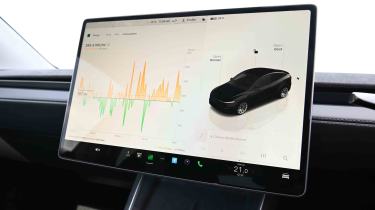
| Pros |
|
| Cons |
|
Crucially for the Model Y and its never-ending battle for range superiority, its aerodynamics were improved with the 2025 updates. It might be classed as a mid-sized SUV but the Model Y has a drag coefficient of 0.22 which is very good compared to its rivals. It’s 0.1 better than before, just a little off the lower Model 3 saloon and the same as the super-sleek Porsche Taycan.
Electric range, battery life and charge time
Tesla has always led the way when it comes to range and efficiency, and that remains the case with the latest Model Y.
Official figures from Tesla quote a range of 311 miles combined for the Standard Range model, while the Long Range is quoted at 387 miles, which is up with the best figures for any EV currently on sale. Adding the AWD powertrain shaves a few miles off the total, but a quoted figure of 364 miles is still pretty strong. The Performance is understandably the least efficient, but a 360-mile range is still respectable.
Our first time behind the wheel of the updated car was of the Long Range All Wheel Drive Launch Edition in temperatures in the high teens and included plenty of motorway miles. It resulted in a figure of 3.9 miles/kWh, which was enough for a range of 293 miles.
On a more relaxed, shorter trip with no motorway driving, the Model Y Long Range All Wheel Drive returned a superb 5.6mi/kWh, which would’ve resulted in the Tesla covering 420 miles between charges. That figure is for a model equipped with the optional 20-inch wheels, which has a slightly shorter official range than versions with 19-inch wheels.
When it comes to charging, few manufacturers can touch the convenience that Tesla can offer. Drive to your nearest Supercharger, park up and plug in. Once you have enough charge, you can leave, and your usage is charged by direct debit each month. We really wish all charging networks were this easy to use. Just don’t forget that EVs from other brands can now utilise the Tesla Supercharging network so you may see non-Teslas in ‘your’ charging bay.
Thanks to its 250kW charging capability, the Model Y is among the fastest-charging cars in its class. Another helpful feature is the Model Y’s ‘pre-charging’, which sets the optimum temperature for the battery ahead of a planned charging stop to ensure the quickest charging speed is achieved. We found that this worked pretty seamlessly, like the Tesla charging experience as a whole.
| Model | Battery size | Range | Insurance group |
| Standard Range | 63kWh | 311 miles | 37 |
| Long Range RWD | 83kWh | 387 miles | 39 |
| Performance | 83kWh | 360 miles | 49 |
Insurance groups
The revised Model Y is cheaper to insure than before, though it’s still more expensive than a Kia EV6 or Hyundai Ioniq 5.
The base model starts off in group 37 (out of 50) having previously sat in group 46. The single-motor Long Range version also dropped, going from 45 to 39 and the dual-motor Long Range went from 48 to 42. The Performance is still in group 49.
Tax
There’s little to separate any EV when it comes to Vehicle Excise Duty (VED) rates now, and beyond the second year, there’s little to split any new cars at all. The Model Y costs £10 in its first year, which rises to £620 for the following five – including the VED surcharge for cars that cost more than £40,000 when new.
Company car users benefit from the lowest Benefit-in-Kind (BiK) tax bandings offered to EVs, and the whole Model Y range is in the three per cent bracket, just like every other electric car on the market. That means there’s more to pay than in the past, but costs of £270 a year for 20 per cent taxpayers for the base car, rising to £312 for the Long Range AWD, are still considerably less than they are for hybrids and PHEVs.
Depreciation
Industry expert CDL estimates that the latest Tesla Model Y will hold on to its value better than many of its rivals. After three years or 36,000 miles, it is expected to be worth roughly half of what it was when it was first registered, with precious little difference between the four variants.
To get an accurate valuation on a specific model check out our free car valuation tool...
Interior, design & technology
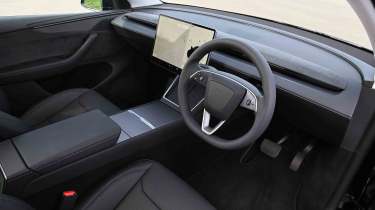
| Pros |
|
| Cons |
|
Don’t go looking for differences between the three Model Y options on the outside, because they look identical. There’s now a Cybertruck-inspired front end with a full-width lightbar, and separate headlights on the re-shaped bumper. The rear’s cosmetic tweaks are even more drastic, with another full-width light that actually reflects back onto the bodywork. It’s a bold design, and one that helps the Model Y stand out in a sea of new rivals.
The Tesla Model Y’s Spartan cabin design lacks many of the physical controls that we take for granted in most new models, replacing them with touchscreen options or the bare minimum of actual buttons. Once you’re used to it, you’ll find that much of the in-car tech is excellent to use.
Interior and dashboard design
The seats are new for the 2025 Tesla Model Y, and they introduce a cooling function for the first time. Storage has been boosted and the sliding doors on many of the cubbies feel of a higher quality than what was there previously.
We’ve said many times how we like physical controls, and the Tesla as so few. Almost everything is controlled through the large, central display. One of the few actual buttons you’ll find is for the hazard warning switch (on the ceiling), but there are extra controls on the steering wheel, including the windscreen wiper washers and the headlight flasher.
The latter works OK in practice, but we still think it’s a poor decision to remove a physical control for the headlights. While automatic lights make this less necessary than before, they’re not perfect; we’d much rather be able to take control manually if we need to. Turning the lights on required a longer press of the button, which can be quite annoying.
It’s a similar story with the indicator stalk. It feels cheap and is a faff to use because it doesn’t click into place – making cancelling a signal needlessly difficult. It’s almost as if Tesla is persuading owners of the merits of touchscreens by deliberately making its physical controls less than ideal.
Materials and build quality
Compared to even five years ago, overall build quality is much better in the Tesla Model Y. We found some passengers had trouble using the flush-fitting door handles, but once you’re inside the Model Y you’re greeted with a typically minimalist cabin.
There are swathes of soft-touch plastic, faux leather and fabric wrapping around the interior, and it all feels tightly put together - some of our passengers even thought the Tesla cost tens of thousands of pounds more than it did. Don’t be scared of getting the black and white interior rather than the purely black trim option, either – the bright white seat coverings felt durable to us and were easy to clean.
Infotainment, sat-nav and stereo
As before, most of the Model Y’s functions are on the massive 15.4-inch central screen – so it’s a good thing Tesla’s infotainment system is responsive, quick and easy to navigate between the various menus. It’s a little overwhelming for first-time users, but the toolbar at the bottom of the screen still has shortcuts to frequently used functions, which simplifies things a bit.
We also liked the Tesla’s sat-nav configuration, which in its satellite imagery mode gives you a perfectly clear and concise view. Along with the great mapping, the navigation for Tesla’s Supercharger network is easy to programme on the move, and it even alerted us when pre-conditioning for the battery began before we arrived at the charging station. Dive into the driving data sections, and it will show some neat graphs, allowing the most nerdy of us to analyse how the car’s energy was used over previous journeys.
Not only is Tesla’s charging network brilliant, but the car helps out there, too. By plotting a route in the navigation, the Model Y will calculate where to stop and how much charge is needed to reach your destination. It will also optimise its battery temperature on the way to a charger, so that charging speeds are as quick as possible upon arrival.
In the back, the facelifted Model Y introduced another eight-inch touchscreen sitting in the middle for climate controls, audio, games and even media applications such as Netflix and YouTube. It’s a nice touch that our passengers appreciated.
“While all brands’ auto wipers are poor, Tesla makes them worse than anyone else. Please, Tesla: just give us a proper wiper stalk with a manual intermittent control.” - Alex Ingram, chief reviewer
Boot space & practicality
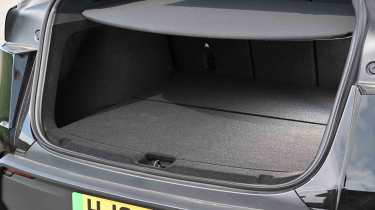
| Pros |
|
| Cons |
|
The Model Y only comes in one bodystyle, unlike some of its rivals that offer both SUV and swoopy coupe-SUV shapes (like the Volkswagen ID.5 and Skoda Enyaq Coupe). The Tesla might have a curved roof like a coupe-SUV, but it’s a tall car so interior space is excellent. The boot is also massive thanks to a low floor - though all of this means the Model Y is more akin to an MPV than an SUV. There’s not a lot of ground clearance so don’t expect to take this big EV anywhere off-road.
Dimensions and size
The Tesla Model Y is one of the larger cars in the compact electric SUV sector. It’s longer and wider than a Hyundai Ioniq 5, but has a shorter wheelbase. This doesn’t have a negative impact on cabin space, however.
| Dimensions comparison | |||
| Model | Tesla Model Y | Kia EV6 | Audi Q4 e-tron |
| Length | 4,790mm | 4,680mm | 4,588mm |
| Width | 1,982mm | 1,880mm | 1,865mm |
| Height | 1,624mm | 1,550mm | 1,632mm |
| Wheelbase | 2,890mm | 2,900mm | 2,764mm |
| Boot space | 890-2,138 litres (both to roof), plus 88 litres under the bonnet | 490 - 1,300 litres | 520 - 1,490 litres |
Seats & passenger space
A completely flat floor makes the back-seat area feel very roomy, even with three people sitting on the bench. While the smaller Model 3 suffers from a high floor relative to the seat base, there are no such issues in the Model Y, which means that taller occupants will still feel comfortable.
Plenty of foot room beneath the front seats and soft, forgiving cushioning help when it comes to passenger comfort, although the centre seat’s backrest is a little hard.
Boot space
Tesla only quotes a boot volume that extends to the roof rather than the window-line figure that most brands use, so the very generous-looking 854-litre capacity needs to be taken with a pinch of salt. However, the space on offer is still enormous when compared with most rivals, and the neat, square load area and relatively low boot lip are extremely well thought out.
Under the boot floor is an additional storage area, which is very deep, improving versatility further. We expect that the 88-litre capacity in the Model Y’s nose will only be utilised on rare occasions when the normal boot is full.
Less impressive is the electric bootlid, which during our week-long test often abruptly stopped because it incorrectly thought there was something in the way.
Towing
A tow hitch is a £1,090 option on every Model Y and all models able to tow up to 1,600kg.
“For 2025, the Model Y’s front boot has been improved with the addition of a drain plug, so if you wish to carry dirty items up front, you can simply hose the area down afterwards.” - Alex Ingram, chief reviewer
Reliability & safety
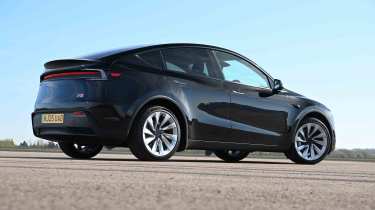
| Pros |
|
| Cons |
|
Tesla achieved an impressive second place overall in our 2024 Driver Power customer satisfaction survey of car brands before dropping to 11th in 2025.
The 2025 Driver Power survey for best cars to own saw the Model Y come an excellent 15th with owners praising software updates, powertrains and running costs.
The Model Y scored a maximum five stars out of five in the Euro NCAP crash test in 2022. It scored higher in the adult occupancy category than rivals like the Hyundai Ioniq 5, Nissan Ariya, Genesis GV60, and Volkswagen ID.5. However, the Volvo EC40 (formerly known as the Volvo C40) scored better in child occupancy protection.
| Euro NCAP safety ratings | |
| Euro NCAP safety rating | Five stars (2022) |
| Adult occupant protection | 97% |
| Child occupant protection | 87% |
| Vulnerable road user protection | 82% |
| Safety assist | 98% |
Buying and owning
Our best buy: Tesla Model Y Long Range AWD
You don’t sacrifice much in the way of range for the added performance and roadholding of the AWD model, and in the past this version has offered a better ride than lower-spec cars. The cheaper Standard Range car is also a great option thanks to the Supercharging network relieving any potential range anxiety from its smaller battery.
Tesla offers buyers a four-year warranty with four years of breakdown cover. The latter is a very generous package, while the former ranks Tesla ahead of the premium German brands, if not the likes of Hyundai, Kia and MG, which provide either five or seven years of manufacturer cover.
The minimal running costs served up elsewhere by the Model Y also apply to servicing. Recommended maintenance consists of a biennial cabin filter change and brake fluid check, plus a suggested tyre rotation every 6,250 miles. Otherwise, there are zero service costs.
Tesla Model Y alternatives
On merit, the Tesla Model Y is one of the best electric SUVs on the market, but Tesla’s boss and his connection with current US politics mean that some people aren’t comfortable taking the plunge. However, there are a few options available that come close to matching the Model Y, with the recently updated Hyundai Ioniq 5 being our top pick as an alternative option. It has the looks of a hatch, but is as big as the Model Y, and offers a long range and spacious accommodation for a similar price - we rated both cars at 4.5 out of five when we tested them together. The Genesis GV60 and Kia EV6 use the same EV technology as the Hyundai, just in different packages that look a little different.
Other options include the Audi Q4 e-tron and Cupra Tavascan, which share the same platform, or the Volkswagen ID.4 and Volkswagen ID.5 duo, again, based on the same running gear as the Audi and Cupra. BYD is a major threat, and its BYD Sealion 7 offers good value for money and plenty of tech. Other options come from BMW in the shape of the BMW iX1 and the coupe SUV BMW iX2, or the Mercedes EQA and the more practical Mercedes EQB.
Deals on the Tesla Model Y and alternatives
Tesla Model Y pictures
Frequently Asked Questions
The Model 3 is slightly faster than the Model Y because while they share the same electric motors, the Model Y is a little heavier.


